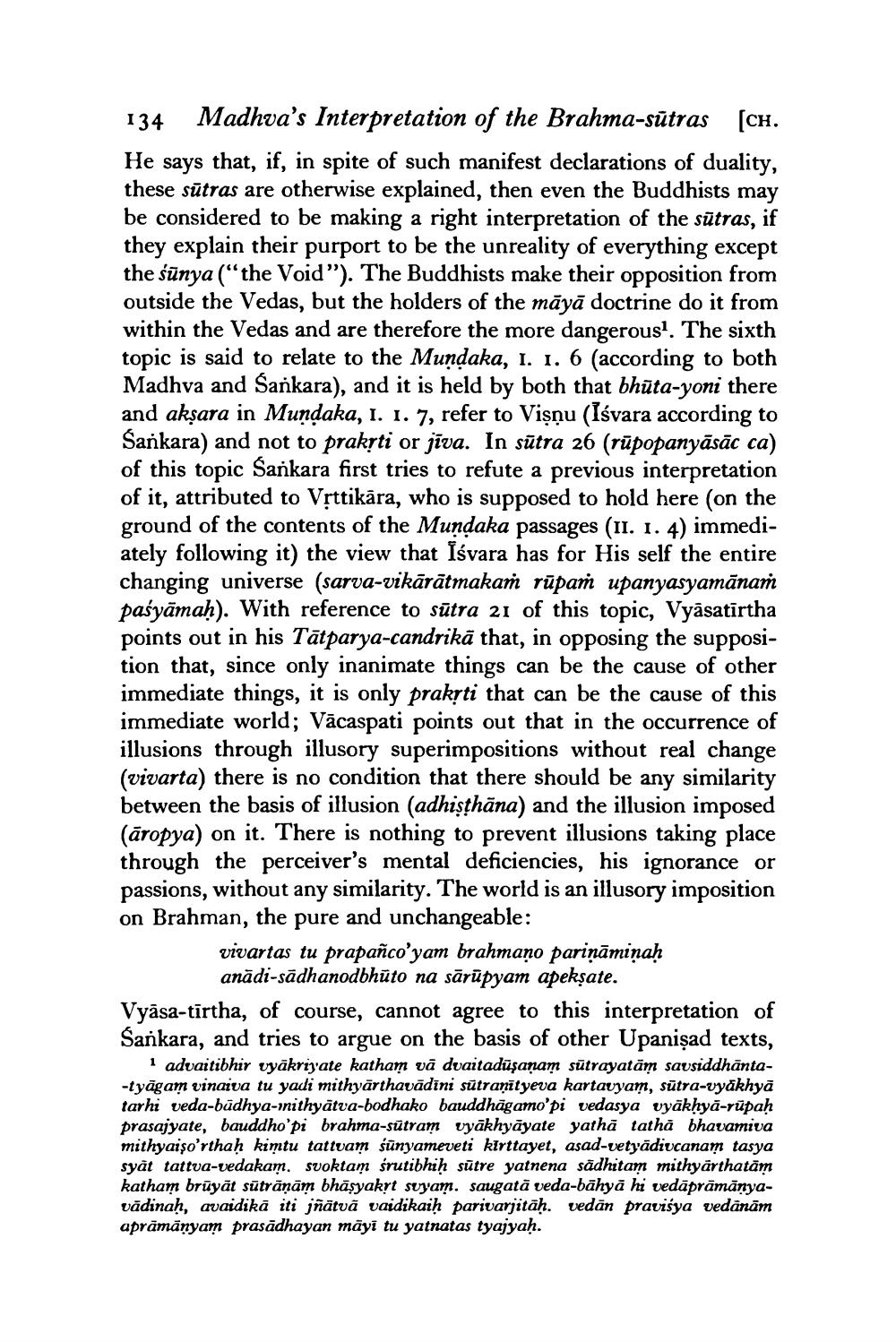________________
134 Madhva's Interpretation of the Brahma-sūtras [CH. He says that, if, in spite of such manifest declarations of duality, these sūtras are otherwise explained, then even the Buddhists may be considered to be making a right interpretation of the sūtras, if they explain their purport to be the unreality of everything except the sūnya ("the Void”). The Buddhists make their opposition from outside the Vedas, but the holders of the māyā doctrine do it from within the Vedas and are therefore the more dangerous. The sixth topic is said to relate to the Mundaka, 1. 1. 6 (according to both Madhva and Sankara), and it is held by both that bhūta-yoni there and akşara in Mundaka, 1. 1. 7, refer to Vişņu (Isvara according to Sankara) and not to praksti or jīva. In sūtra 26 (rūpopanyāsāc ca) of this topic Sankara first tries to refute a previous interpretation of it, attributed to Vịttikāra, who is supposed to hold here (on the ground of the contents of the Mundaka passages (11. 1. 4) immediately following it) the view that Isvara has for His self the entire changing universe (sarva-vikārātmakam rūpam upanyasyamānam paśyāmaḥ). With reference to sūtra 21 of this topic, Vyāsatīrtha points out in his Tātparya-candrikā that, in opposing the supposition that, since only inanimate things can be the cause of other immediate things, it is only prakrti that can be the cause of this immediate world; Vācaspati points out that in the occurrence of illusions through illusory superimpositions without real change (vivarta) there is no condition that there should be any similarity between the basis of illusion (adhisthāna) and the illusion imposed (āropya) on it. There is nothing to prevent illusions taking place through the perceiver's mental deficiencies, his ignorance or passions, without any similarity. The world is an illusory imposition on Brahman, the pure and unchangeable:
vivartas tu prapanco'yam brahmano pariņāminah
anādi-sādhanodbhüto na sārūpyam apeksate. Vyāsa-tīrtha, of course, cannot agree to this interpretation of Sankara, and tries to argue on the basis of other Upanişad texts,
advaitibhir vyākriyate katham vā dvaitadūşanam sūtrayatām savsiddhānta-tyāgam vinaiva tu yadi mithyārthavādini sūtranītyeva kartavyam, sūtra-vyakhyā tarhi veda-būdhya-nithyātva-bodhako bauddhāgamo'pi vedasya vyakhya-rupah prasajyate, bauddho'pi brahma-sūtramvyakhyāyate yathā tathā bhavamiva mithyaişo'rthaḥ kimtu tattvam sūnyameveti kirttayet, asad-vetyādiucanam tasya syåt tattva-vedakam. svoktam śrutibhiḥ sūtre yatnena sādhitam mithyárthatām katham brāyāt sūtrānām bhāsyakıt suyam. saugatā veda-bahyā hi vedāprāmānyavādinah, avaidikā iti jñātvā vaidikaiḥ parivarjitān. redan pravisya vedānām aprāmānyam prasādhayan māyi tu yatnatas tyajyah.




